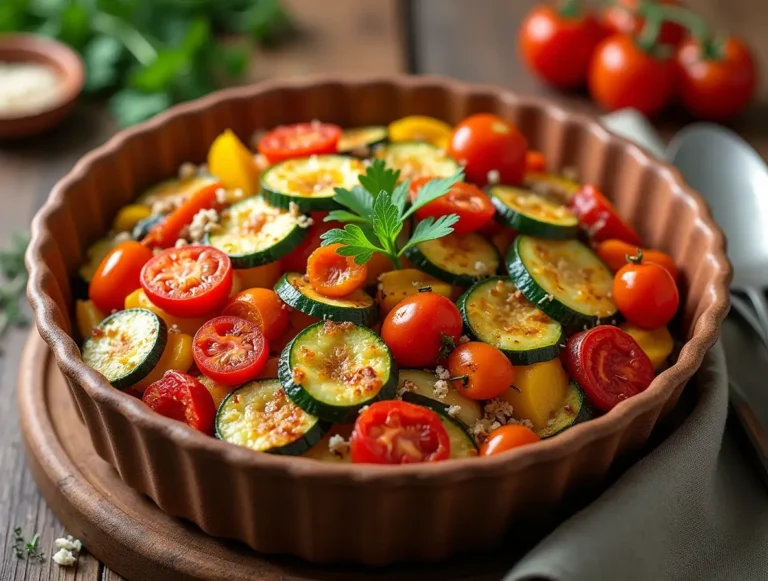Nutritious healthy Vegetable Bakes That Make Healthy Eating Simple
As a busy parent, I know how hard it is to eat healthy. Work, family, and tempting convenience foods make it tough. But, there’s a simple way to make healthy eating easy. The answer is the humble vegetable bake.
Veggie bakes are the heroes of healthy eating. They’re full of nutrients and taste great. They’re perfect for meal prep, brunch, or a comforting dinner. These casseroles are exactly what you need.
Table of Contents
Understanding the Benefits of Vegetable Bakes for Clean Eating
Starting a clean eating lifestyle is great for your health. Vegetable bakes, like roasted veggies and casseroles, are full of nutrients. They taste good and give your body what it needs to work well.
Essential Nutrients in Baked Vegetables
Baked veggies are rich in dietary fiber, which is good for your gut. They also have vitamins A, C, and K, and minerals like potassium and magnesium. These nutrients boost your immune system, skin, and bones.
Why Baking Preserves Nutritional Value
Baking veggies keeps more nutrients than boiling. It saves vitamins, minerals, and antioxidants. So, baked veggies are a better choice for your meals.
Health Benefits of Plant-Based Casseroles
Plant-based casseroles are perfect for clean eating. They’re low in calories but full of fiber and nutrients. Adding protein like legumes or tofu makes them a balanced and filling meal.
Adding vegetable bakes to your diet is easy and tasty. They help you eat well and live healthy. Baked veggies are a delicious way to meet your wellness goals.
Essential Ingredients for a Healthy Vegetable Bake
Making a tasty and healthy vegetable bake starts with picking the right ingredients. Choose a mix of fresh, colorful veggies like broccoli, cauliflower, carrots, zucchini, and Swiss chard. These veggies add flavor and important nutrients like vitamins, minerals, and fiber.
Adding a protein source, like tofu or legumes, makes the dish more filling. Herbs and spices add depth of flavor. A sauce made from vegetable broth, white wine, or sherry helps everything stick together.
For those who eat meat, cheese can add a creamy touch and savory taste. But, if you’re watching what you eat, try almond flour or gluten-free flour instead. Eggs or plant-based binders can also help the casserole stay together.
| Ingredient | Purpose |
|---|---|
| Broccoli, Cauliflower, Carrots, Zucchini, Swiss Chard | Nutrient-dense vegetables |
| Tofu or Legumes | Protein-rich additions |
| Herbs and Spices | Aromatic enhancers |
| Vegetable Broth, White Wine, Sherry | Flavorful sauces |
| Cheese (for non-vegan options) | Creamy texture and savory notes |
| Almond Flour, Gluten-Free All-Purpose Flour | Flour alternatives for dietary restrictions |
| Eggs or Plant-Based Binders | Binding agents |
By choosing these key ingredients, you can make a healthy vegetable bake that tastes great and is good for you. Try out different combinations to find the perfect recipe for your taste and dietary needs.
Step-by-Step Guide to Creating Perfect Veggie Casseroles
Making tasty and healthy vegetable casseroles is simpler than you might think. The secret is in how you prepare and layer the ingredients. This ensures even cooking and delicious results. Let’s dive into the steps for making perfect easy vegetable casserole and healthy vegetable casserole recipes every time.
Proper Vegetable Preparation Techniques
Start by washing and cutting your veggies into the same size pieces. This helps them cook evenly. For tough veggies like cauliflower or broccoli, boil them briefly before assembling. This makes them tender.
Layering Methods for Even Cooking
When making your veggie casserole, layer the ingredients with care. Begin with sturdy veggies like potatoes or carrots. Then add softer ones like zucchini or spinach. Add protein sources like cooked chicken or beans, and top with a creamy sauce or cheese. This method ensures even cooking.
Temperature and Timing Guidelines
For the best results, bake your casserole at 350-400°F (175-200°C) for 20-45 minutes. Watch it closely, making sure the cheese is melted and bubbly. Let it cool for 10 minutes before serving. This allows the flavors to blend and the dish to set.
By following these steps, you’ll make delicious, easy vegetable casserole and healthy vegetable casserole recipes. Your family and friends will love them.
Low-Calorie Vegetable Bake Variations
Living healthy doesn’t mean you have to give up taste. Low-calorie vegetable bakes are a tasty, nutritious choice for those who love clean eating. You can try a Greek-inspired stuffed eggplant or a spinach and white bean potpie. These dishes use lean proteins, lots of veggies, and light sauces to keep calories low but still taste great.
Adding ingredients like kale, quinoa, and reduced-fat cheeses boosts nutrition without adding too many calories. Try mixing different veggies and spices to make tasty, low-calorie meals that meet your health goals.
| Vegetable | Amount | Calories (per 100g) |
|---|---|---|
| Red Bell Pepper | 60g | 31 |
| Red Onion | 40g | 40 |
| Broccoli | 80g | 34 |
| Cauliflower | 70g | 25 |
| Brussels Sprouts | 50g | 43 |
These veggies are great for healthy eating and clean eating recipes because they’re low in calories. Baking them with olive oil, garlic, and thyme makes a delicious, low-calorie dish that’s full of flavor.
“Embracing low-calorie vegetable bakes is a delicious way to nourish your body while enjoying the flavors you love.”
Gluten-Free and Dairy-Free Baking Options
Living gluten-free or dairy-free doesn’t mean you have to miss out on tasty vegetable bakes. You can make gluten-free vegetable casserole and vegan vegetable casserole that are just as good. These options are perfect for different diets and still taste great.
Alternative Flour Choices
For a gluten-free base, try almond flour, oat flour, or gluten-free all-purpose flour. These flours help your vegetables stay together and taste wonderful.
Plant-Based Cheese Substitutes
Use dairy-free cheese made from nuts, nutritional yeast, or vegan cheese. These alternatives melt and taste creamy, just like the real thing.
Binding Agents for Special Diets
- Egg replacers: For vegans, try commercial egg replacers or flaxseed or chia seeds mixed with water.
- Almond milk or other non-dairy milk: Use almond milk, oat milk, or your favorite plant-based milk to keep it dairy-free.
With these easy swaps, you can enjoy a gluten-free vegetable casserole or vegan vegetable casserole that’s both tasty and healthy. It meets your dietary needs without losing flavor or quality.
Seasonal Vegetable Combinations for Year-Round Baking
Using seasonal produce can make your roasted vegetables, healthy bakes, and casseroles taste amazing. Spring brings asparagus and peas, while summer offers zucchini and tomatoes. Fall is all about butternut squash and Brussels sprouts, and winter brings kale and sweet potatoes.
When making your vegetable bakes, mix different seasonal ingredients. This makes your dishes more nutritious and saves money. Try new herbs and spices to match each season’s flavors.
| Season | Recommended Vegetables |
|---|---|
| Spring | Asparagus, Peas, Radishes, Spinach |
| Summer | Zucchini, Tomatoes, Corn, Eggplant |
| Fall | Butternut Squash, Brussels Sprouts, Carrots, Potatoes |
| Winter | Kale, Sweet Potatoes, Parsnips, Onions |
By using seasonal ingredients, you can enjoy delicious and healthy roasted vegetables, healthy vegetable bakes, and veggie casseroles all year. Each season brings its own unique flavors.

Make-Ahead Tips and Storage Solutions
Preparing nutritious and easy vegetable casseroles doesn’t have to be time-consuming. With a few simple make-ahead tips, you can enjoy the convenience of healthy vegetable casserole recipes any time.
Proper Cooling and Storing Methods
To get a head start on your vegetable bake, you can prep the casserole up to 24 hours in advance. Just assemble the dish, cover it, and refrigerate until ready to bake. When storing leftovers, cool the casserole completely before putting it in an airtight container. Refrigerate for up to 5 days or freeze for up to 3 months for longer-term storage.
Reheating Guidelines for Best Results
When it’s time to enjoy your easy vegetable casserole again, you have a few options for reheating. For individual portions, a quick zap in the microwave works well. For larger servings, place the casserole in a preheated 350°F (175°C) oven for 20-30 minutes. Remember to add a sprinkle of water or broth to prevent the dish from drying out during reheating.
By mastering the art of make-ahead preparation and proper storage, you can savor the flavors of your healthy vegetable casserole recipes whenever the craving strikes. With a little planning, you’ll have nourishing and delicious meals ready to go at a moment’s notice.
Protein-Rich Additions for Complete Meal Bakes
Make your plant-based meals even better by adding protein-rich ingredients. Whether you’re a vegetarian, vegan, or just want healthier dinners, there are many options. These ingredients can make your meals more balanced and nutritious.
Try adding tofu, tempeh, or legumes like chickpeas, lentils, or black beans to your veggie casseroles. These add protein, making your healthy vegetable bake more filling and nutritious. If you eat meat, lean options like chicken or turkey work well too.
Whole grains, such as quinoa, are also key. They add protein and nutrients, making your plant-based meal complete. This turns your nutritious dinner into a satisfying, well-rounded dish.
Boost your veggie bakes with protein-rich veggies like broccoli and spinach. Adding nuts or seeds, like almonds, walnuts, or pumpkin seeds, increases protein and adds crunch.
With these protein-rich additions, your vegetable bakes become full, balanced meals. They meet different dietary needs and tastes. Enjoy the health benefits and hearty taste of these dishes.
Tips for Enhancing Flavor Without Added Calories
Creating tasty and healthy vegetable bakes is all about flavor without extra calories. Use herbs, spices, and umami-rich ingredients to make your low-calorie dish delicious.
Begin with aromatic herbs and spices like garlic, paprika, cumin, or Italian seasoning. These can make your clean eating recipe taste great without extra fats or sugars. For a deeper flavor, add nutritional yeast, miso paste, or sautéed mushrooms.
Roasting garlic or onions can also add sweetness and depth. These steps can make your vegetable bakes rich without using many calories. Acids like vinegars or lemon juice can also brighten the flavors.
For sauces and gravies, choose low-sodium broths or a bit of wine for richness. Roasting your veggies before baking can also boost their taste. This makes your healthy vegetable bake even more satisfying.
“Flavor doesn’t have to come at the expense of your health. With a few simple tricks, you can create delicious, low-calorie vegetable dishes that will leave you feeling nourished and satisfied.”

Conclusion
Vegetable bakes are a great choice for those looking for healthy vegetable bake options. They are both nutritious and delicious. You can make them fit many diets, like gluten-free or vegan, making them perfect for meal prep or family dinners.
By using seasonal veggies, adding protein, and enhancing flavors, these clean eating recipe bakes become a must-have in any healthy kitchen. They offer important nutrients, fiber, and tasty flavors. This makes them a great pick for anyone wanting to eat better without sacrificing taste.
Choosing healthy vegetable bake recipes can help you reach your wellness goals. Plus, you get to enjoy a homemade meal. So, why not try out these nutritious and flavorful vegetable bakes? Your body and taste buds will appreciate it.
Top Reviews and Expert Insights on Casserole Recipes
There are no reviews yet. Be the first one to write one.







